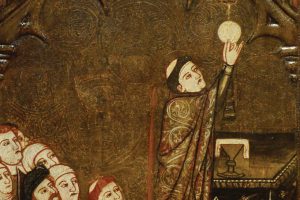Defying the stereotypes of a meek, mild-mannered Mary, the Magnificat proclaims the liberating and revolutionary message of a passionate, prophetic woman. In her new book, Elizabeth A. Johnson takes a critical look at Mary—who she is and what she represents in the 21st century.
The first-century Jewish woman named Miriam of Nazareth, mother of Jesus, is the most celebrated female religious figure in the Christian tradition. She has been symbolized to such an extravagant degree, divorced from her own history—symbol of the maternal face of God, of the eternal feminine, of the disciple, of the idealized church—that approaching her as an actual human being surprises us.
Whether studies from the point of view of theology, spirituality, or culture, this Galilean woman has been interpreted and explained, imagined and rejected, loved and honored in ways so diverse as to be impossible to codify.
Professor Mary Hines tells the story of the beginning of one semester at a theological school when she discovered that all the students registered for her course on the theology of Mary were young men; all the students in her course on feminist theology were women. When asked to explain their choices, the men said they knew next to nothing about the church’s teaching on Mary but as ordained ministers would be expected to. The women, on the other hand, avoided the course because of their negative feelings about what they already knew. “Some responded with a sense of betrayal and disillusionment, some with a sense of undefined unease,” Hines said. “Some said there was just too much baggage for them to summon up interest in studying Mary.”
Today we are faced with the task of developing and promoting a theologically sound, ecumenically fruitful, spiritually empowering, ethically challenging, and socially liberating interpretation of Mary for the 21st century. What is her significance in the light of Christian faith in the gracious mystery of God? What difference does remembering her make in the life of church and society? How can her image be construed as a source of blessing rather than a blight for women’s lives in both religion and politics?
There is no one thread that would knit this tradition around Mary into a unified whole. While a historical woman obviously dwells at the root of this whole phenomenon, there has been a plasticity to her image that has allowed us to create widely different Marian symbols and theologies in relation to spiritual and social needs.
The diversity begins in scripture, where each of the four gospels portrays her in a different way according to the theological perspectives of the evangelists. Within the gospels are at least 13 scenes where Miriam of Nazareth, identified either by her own name or as the mother of Jesus, speaks, takes action, or is described as an essential part of the action. Drawing on these various gospel portraits, then, gives different glimpses or brief portrayals of incidents in Mary’s life.
Mary’s prophetic song
One of the longest glimpses of Mary is at the beginning of the gospel of Luke, when, pregnant with Jesus and visiting Elizabeth, Mary sings the Magnificat (Luke 1:46–55).
“The song of Mary is the oldest Advent hymn,” preached Dietrich Bonhoeffer, the German theologian killed by the Nazis. “It is at once the most passionate, the wildest, one might even say the most revolutionary Advent hymn ever sung. This is not the gentle, tender, dreamy Mary whom we sometimes see in paintings; this is the passionate, surrendered, proud, enthusiastic Mary who speaks out here.”
“This song,” Bonhoeffer continues, “has none of the sweet, nostalgic, or even playful tones of some of our Christmas carols. It is instead a hard, strong, inexorable song about collapsing thrones and humbled lords of this world, about the power of God and the powerlessness of humankind. These are the tones of the women prophets of the Old Testament that now come to life in Mary’s mouth.”
Swelling with new life by the power of the Spirit and affirmed by her kinswoman Elizabeth, Mary sings a song that proclaims God’s gracious, effective compassion.
This is the most any woman gets to say in the New Testament. While we are told that other women proclaim the Good News, most significantly at the empty tomb on Easter morning, we unfortunately do not get to hear their own words.
The cadences of Mary’s canticle call into question any such traditional silencing of women’s voices, whether in scripture or throughout tradition. Following the logic of her praise of God, all voices, especially the voices of the lowly, should be welcome in the assembly.
And Mary said:
My soul magnifies the Lord, and my spirit rejoices in God my Savior, for he has looked with favor on the lowliness of his handmaid.
For behold, henceforth all generations will call me blessed, for the One who is mighty has done great things for me, and holy is his name.
And his mercy is from generation to generation on those who fear him.
He has shown strength with his arm; he has scattered the proud in the imagination of their hearts; he has put down the mighty from their thrones, and exalted those of low degree; he has filled the hungry with good things, and the rich he has sent away empty.
He has helped his servant Israel, in remembrance of his mercy, according to the promise he made to our ancestors, to Abraham and to his posterity forever.
Mary stands in the long Jewish tradition of female singers, from Miriam with her tambourine (Exod. 15:2–21) to Deborah (Judg. 5:l–31), Hannah (1 Sam. 2:1–10), and Judith (Jdt. 16:1–17), who also sang songs of salvation, victory songs of the oppressed.
Structured as a thanksgiving psalm, the Magnificat has two parts. The first praises God’s mercy to the speaker and the second reflects God’s victorious deeds for the oppressed. The two parts are linked by a profound sense of God’s faithful compassion, by the joy that results in the lives of the liberated, and by virtue of the fact that Mary herself is a member of the oppressed people who experience redemption. Together, they reflect a way of life basic to Jewish and Christian traditions: spirituality and social justice.
God’s mercy to the peasant woman
The song begins with a poor woman’s cry of joy. Mary’s spirit rejoices in “God my Savior.” This lyric mood pervades the Jewish biblical tradition. The psalmist sings, “Then my soul shall rejoice in the Lord, exulting in his deliverance” (Ps 35:9). Isaiah encourages, “This is the Lord for whom we have waited; let us be glad and rejoice in his salvation” (Isa. 25:9). Even the natural world is caught up in the gladness: “Let all the earth cry out to God with joy” (Ps 66:1).
This is not a superficial joy—it is aware of the struggle unto death yet hopeful that the great “nevertheless” of God leads to life. Mary magnifies God her Savior, which in Elizabethan English means to celebrate the greatness, or sing and dance in praise of the goodness of someone wonderful. Hers are not the words of half-hearted appreciation. She feels herself lifted up into God’s good and gracious will, and she breaks forth in praise and singing.
Mary’s song is the prayer of a poor woman. She proclaims God’s greatness because the Holy One, regarding her low estate, has done great things for her.
The term for lowliness in Greek describes misery, pain, persecution, and oppression. Mary’s self-characterization as lowly is not a metaphor for spiritual humility but is based on her actual social position. Young, female, a member of a people subjected to economic exploitation by powerful rulers and afflicted by outbreaks of violence, she belongs to the poor.
Yet it is to precisely such a woman that the call has come to partner with God in the great work of redemption. It is not just that God often chooses unconventional people for a task, not just that Mary is among the inconsequential poor of the earth, like unlettered women in any poor village on this planet. It is the combination that is revolutionary: God has regarded her precisely as a lowly woman. Her favored status, declared by Gabriel, Elizabeth, and now herself, results from God’s surprising and gracious initiative. Rejoicing follows. Here the background picture of a poor, first-century Galilean peasant woman living in occupied territory, struggling for survival and dignity, imbued with Jewish faith, aptly joins with this biblical portrait of Mary, singer of the song of justice in the name of God.
In his commentary on this canticle, Martin Luther teaches that, as in Mary’s case, God desires to do great things for us too, despite our lowliness. What we need is faith, trusting in God as Mary did with “her whole life and being, mind and strength.” Then we will be caught up in God’s good and gracious will, which operates with kindness, mercy, justice, and righteousness. True, this always involves a reversal of values, and, Luther observes, “The mightier you are, the more must you fear; the lowlier you are, the more must you take comfort.”
But just as the Spirit inspires Mary’s joy and fortitude, so too the Spirit imbues us every day with abundant grace to follow our own calling. The important thing to remember is that Mary had confidence in God. “Thus we too should do; that would be to sing a right Magnificat.”
God’s mercy to the oppressed
What begins as praise for divine loving-kindness toward a marginalized and oppressed woman grows to embrace all the poor of the world. The second part of the Magnificat articulates the great biblical theme of reversal, where lowly groups are defended by God while the arrogant end up losers.
Proclaiming her song, Mary continues this deep stream of Jewish faith in the context of the advent of the Messiah, now taking shape within her. The approaching reign of God will disturb the order of the world run by the hard of heart, the oppressor. Through God’s action, the social hierarchy of wealth and poverty, power and subjugation, is to be turned upside down. all will be well because God’s mercy, pledged in covenantal love, is faithful through every generation.
By placing the Magnificat on the lips of Mary, Luke depicts her as the spokeswoman for God’s redemptive justice. She proclaims the Good News by anticipation, and she does so as a woman whose consciousness is rooted in the heritage and wisdom of the strong women of Israel. Knowledgeable about the liberating traditions of her own people and trumpeting them with “tough authority,” Mary stands as a prophet of the coming age.
Rooted in the biblical heritage of Palestinian Jewish society, this is clearly a revolutionary song of salvation that’s concrete social, economic, and political dimensions cannot be blunted. People are hungry because of triple taxes being exacted for Rome, the local government, and the temple. The lowly are being crushed because of the mighty on their thrones in Rome and their deputies in the provinces. Now, with the nearness of the messianic age, a new social order of justice is at hand. Mary’s canticle praises God for the kind of salvation that involves concrete transformations.
People in need in every society hear a blessing in this canticle. The battered woman, the single parent without resources, those without food, the homeless family, the young abandoned to their own devices, the old who are discarded—all who are subjected to social contempt are encompassed in the hope Mary proclaims.
The church in Latin America more than any other is responsible for hearing this proclamation of hope in a newly refreshed way. The Magnificat’s message is so subversive that for a period during the 1980s the government of Guatemala banned its public recitation. Seeing the central point of this song to be the assertion of the holiness of God, Peruvian theologian Gustave Gutierrez argues that any reading is fruitless that “attempts to tone down what Mary’s song tells us about the preferential love of God for the lowly and the abused, and about the transformation of history that God’s loving will implies.”
This message will not appeal to those who are satisfied with the ways things are or to those who seek to restore intact some past era of culture or religion. Even affluent people of good will have difficulty dealing with its shocking, revolutionary ring.
Doesn’t God love everyone? Indeed yes, but in an unjust world, the form this universal love takes differs according to circumstance. This song makes clear that divine love is particularly on the side of those whose dignity must be recovered. The divine intent is to build up a community marked by human dignity and mutual regard.
Georgetown theologian John Haught writes, “A major part of the message of prophetic religion is that the dreams that arise among the poor are not naive illusions but compelling clues to the nature of the real.” Those who are affluent need to dream with the poor the dream of God’s future that their suffering opens up, and thus be transformed themselves. For both poor and affluent, the Magnificat is a vehicle of that dream.
Mary not only sings of God’s liberating transformation of the social order, but, like those in her song, she occupies a position of poverty and powerlessness in her society and does so with the added oppression that accrues to being a woman of little account. Hence her song puts her in solidarity with other women who strive for life. She sings pregnant with hope, bearing the Messiah, embodying the historic reversal she proclaims.
Who shall mother the Messiah? Not someone blessed with a bounteous table and a peaceful life, not a well-regarded woman of influence. Indeed, there is nothing wrong with these things: Peace and abundant nourishment are among the blessings hoped for in the messianic age. But the world is distorted by sin. People accumulate power and wealth at the expense of others. Suffering is rampant. And the pattern persists through the generations.
Hearing the cries of the oppressed, God aims to make the world right again, being faithful to the covenant promise. Thus God’s choice of Mary to give birth to the Messiah is typical of divine action.
Read through these eyes, Mary’s song of divine victory over the powerful becomes a song about the liberation of the most nondescript poor people on this earth. Imagine the world according to the defiant Mary’s Magnificat, invites African writer Peter Daino: a heavenly banquet and all the children fed.
Through women’s eyes
Mary’s song of God’s victory over those who dominate others rings with support for women in the struggle against sexism as well as against racism, classism, heterosexism, and all other demeaning injustice. The Spirit who filled Mary with life and empowered her prophetic voice is the same Spirit who inspires and fills with life women of all ages. Remembering her, women draw many and varied lessons of encouragement.
One of the strongest and most unusual lessons in the light of traditional Mariology is the right to say no. “Men toiling in the service of male power interests represent Mary only as the woman who knew how to say yes,” liberation theologian Leonardo Boff writes. Indeed, at the Annunciation Mary uttered her yes to the call of God’s Spirit, a consent to adventure that has been used to promote the passive submission of women.
Here she takes on as her own the divine no to what crushes the lowly. She stands up fearlessly and sings out that it will be overturned. No passivity here, but solidarity with divine outrage over the degradation of life and with the divine promise to repair the world. In the process she bursts out of the boundaries of male-defined femininity while still every inch a woman. Singing of her joy in God and God’s victory over oppression, she becomes not a subjugated but a prophetic woman.
Catholic women wrestle with the significance of this canticle for their own subordinate position in current church structures. With no little irony, Brazilian theologians Ivone Gebara and Maria Clara Bingemer cite the homily preached by Pope John Paul II in Zapopan, Mexico, where he pointed to Mary of the Magnificat as a model for those “who do not passively accept the adverse circumstances of personal and social life and are not victims of alienation, as they say today, but who, with her, proclaim that God ‘raises up the lowly’ and, if necessary, overthrows the powerful from their thrones.’ ”
If this is applied to women’s struggle for full participation in governance and ministry in the church, the reversals of the Magnificat become rife with significance. Mary’s prophetic speech characterizes as nothing less than mercy God’s intervention into a patriarchal social order.
Not only Mary, but the women disciples in Luke grasp that God is no longer to be sought in the clouds, as the men of Galilee once thought, but here on Earth, in the flesh, in birth, and in a grave, however surprisingly empty. God is to be sought and found in daily encounters with suffering, in tears and in the laughter of the poor, and in the groaning of creation.
Theologian Susan Ross’ critique spells out the implications. In many ways in the church, the mighty still occupy their thrones; the lowly still await their exaltation. “Women’s very real lack of power in the church today stands as an indictment of the power structures as they exist. . . . The scandal of women’s exclusion from power cannot be overlooked. Therefore any discussion of the empowerment of women must be juxtaposed with our lack of political and symbolic power and the failure of the leadership of the church to rectify this scandal.”
In addition to hope against their dispossessed status, women glean from this song encouragement for their own creative behavior. Feminist theologian Rosemary Radford Ruether sees in it an example of a woman becoming a theological agent in her own right, actively and cooperatively figuring out the direction of the Spirit.
Poet and essayist Kathleen Norris treasures Mary as an original biblical interpreter, linking her people’s hope to a new historical event. Noting the powerful proclamation of the Good News that issues from Mary’s mouth, feminist theologian Jane Schaberg writes, “Without an explicit commission to preach, she preaches as though she was commissioned,” that is, with authority. In the struggle against sexism in the church, the great reversals roll on, their tone of judgment and promise resounding in the voices of prophetic women today.
A song for all of us
It is above all in the reflections of women in the church of the poor that the profound dimensions of Mary’s prophecy become clear. The 1979 Puebla document, issued by the bishops of Latin America, describes the situation: “The poor do not lack simply material goods. They also miss, on the level of human dignity, full participation in sociopolitical life. Those found in this category are principally our indigenous people, peasants, manual laborers, marginalized urban dwellers, and in particular, the women of these social groups. The women are doubly oppressed and marginalized” because they are women in a society where machismo reigns.
Latin American women in Christian communities recognize a striking analogy between their own situation and that of Miriam of Nazareth. Both dwell in poverty as a result of structural injustices in the economic order; both inhabit worlds organized around the idea of masculine superiority and the inhibition of women’s gifts. Appreciation grows: Mary is one of us.
Mary sings this song as a woman of the people, like millions of poor peasant women in Latin America, doubly and triply oppressed, old before their time. God regards her lowliness, as God regards theirs. Pregnant with new life, she cries out for transformation of the old order, as do they. She belongs to the tradition of women who beget their people amid suffering and despair. Who but a strong decisive woman would call down God’s justice on the heads of the oppressors of the poor?
Her song sets out the game plan of the coming reign of God. It reveals that women fully participate in announcing and bringing about these redemptive changes. And it keeps hope alive that poor women themselves will taste justice on this earth according to the promise that God’s “mercy is from age to age, on those who fear him.”
The Magnificat gives us an image of Mary speaking with prophetic authority a liberating hymn of praise. Regarding this canticle, Luther observed: “She sang it not for herself alone but for all of us, to sing it after her.” Doing so places us in intense relationship to the God who regards suffering with utmost mercy and summons us into the struggle to build a just world.
This article appeared in the December 2003 issue of U.S. Catholic magazine (Vol. 68, No. 12, pg. 12).














Add comment